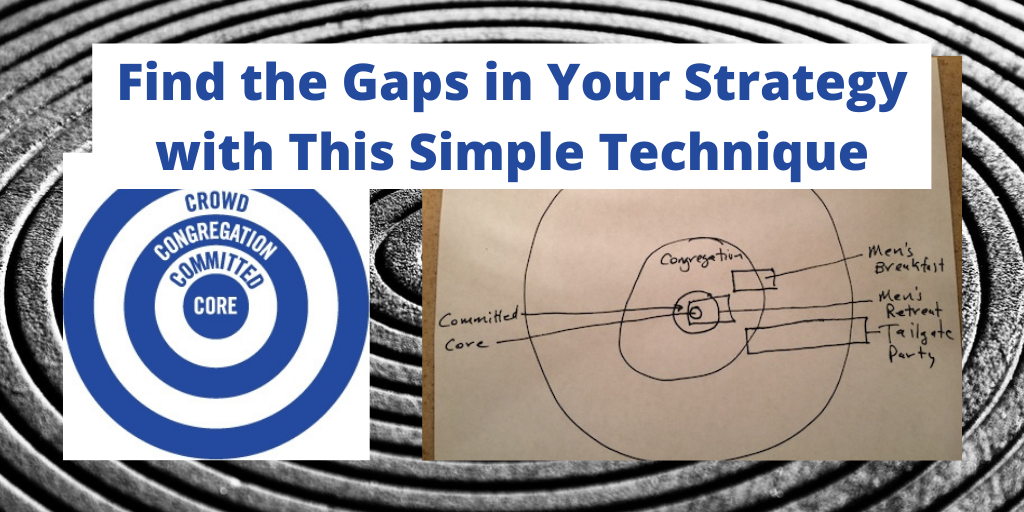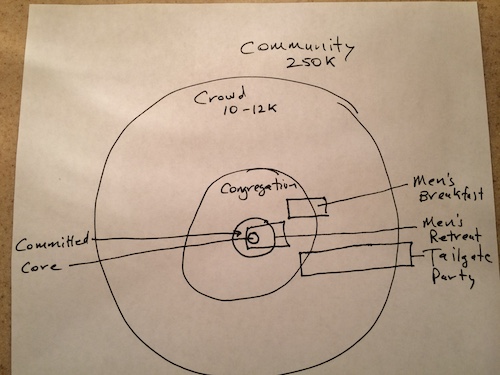Find the Gaps in Your Strategy with This Simple Technique
 I love Rick Warren's concentric circles diagram; a classic illustration of the different segments of people who are associated with your church. The concentric circles also provide a visual representation of Saddleback's crowd-to-core strategy. See also, Crowd-to-Core: An Essential Understanding.
I love Rick Warren's concentric circles diagram; a classic illustration of the different segments of people who are associated with your church. The concentric circles also provide a visual representation of Saddleback's crowd-to-core strategy. See also, Crowd-to-Core: An Essential Understanding.
The way I talk about crowd-to-core is that I want to design next steps for every Ridger (crowd, congregation, committed and core) and first steps for their friends (community). And of course, when I draw the circles I don't draw them the way they are in the diagram (equally spaced). I draw them as I believe they are at Canyon Ridge (see below). And as I draw the circles I talk about what they represent this way:
- Outside of this circle is the community. In the 8 zip codes we draw from there are 250,000 people.
- Inside the circle is the crowd. Based on our Easter numbers and our Christmas Eve numbers, we estimate there are between 10,000 and 12,000 adults who consider Canyon Ridge to be their church. They don't come every week and they may only attend a few times a year.
- Inside the crowd is the congregation (when I draw this circle I try to accurately represent the size, 2500 to 3500 adults). These people attend more frequently, 2 to 3 times a month. They are usually connected in some way (i.e., they may be in a small group, on a serving team, etc.). They give on a regular basis, but it is probably not a tithe.
- Inside the congregation is the committed. They attend 3 to 4 times a month. They definitely serve and often are leaders of groups, teams, or ministries. They tithe. There are hundreds of these people.
- And finally, inside the committed is the core. They don't miss a week and are believers of "attend one, serve one." They give sacrificially. They serve sacrificially. There are less than 300 of these people.
See how I use the diagram to segment the basic kinds of people who attend?

Find the gaps in your strategy with this simple technique:
Here's how you can use it to illustrate the gaps in your strategy. In my own diagram here, I've focused on our men's ministry and three of their events.
- Take an honest look at each of the existing ministries, programs, classes and events and determine which segment of the church are they really designed for. Honesty is essential. You get nowhere with this is you turn a blind eye to what's really going. Brutal honesty is required.
- Try to overlay them on the concentric circles to illustrate who you believe each menu item exists for.
- In order to truly have next steps for everyone and first steps for their friends, there will be no gaps. When you identify gaps you need to create the steps that are missing (that will help everyone take a step). See also, How to Design Next Steps and First Steps.
Cautions:
- Insiders have great difficulty recognizing that the programs they love don't work for everyone.
- Leaders of existing programs often see the world through rose colored glasses and don't understand why everyone doesn't come.
- Most people need to be coached to see the wisdom that just like restaurants have a target customer, so do good programs, events, ministries, and classes.
See also:

